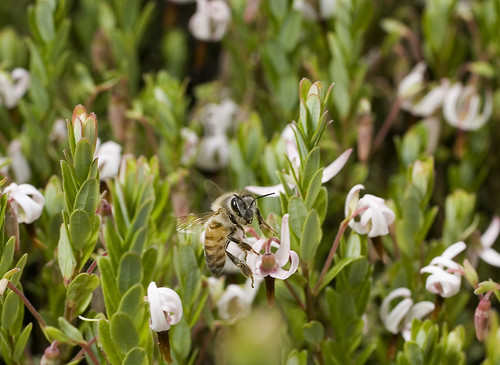
Implementing conservation practices on lands will help provide safe and diverse food sources for honey bees, like the one pictured.
Pam Gasper, of Chaseburg, Wisconsin, has been a bee keeper for the past three years. She recently restored 2 acres on her property to include natural habitat for bees through USDA’s Natural Resources Conservation Service (NRCS) Environmental Quality Incentives Program (EQIP). A dry summer and harsh winter in 2014 caused Pam to lose two of her three honey bee hives. She’s done her research, received technical and financial assistance from NRCS, and made some proactive changes for 2015. Pam is expecting a good harvest and “sweet reward” due to financial and technical assistance through EQIP from NRCS. She’s a strong advocate for the program and said the sign-up process was smooth and worth it.
NRCS staff provided financial assistance through EQIP and also the technical assistance Pam needed, including, site visits, a planting plan, providing options for obtaining seeds, and completing the final inspection of the successful planting just last week. Technical and financial assistance from agencies such as USDA−NRCS and programs like EQIP work to assist land users in accomplishing their goals.
Pam’s goal as a landowner is to proactively keep her acres pollinator friendly. She, and the owners surrounding her property, use no pesticides. “I want to make sure there is plenty of food for the bees, so I applied for EQIP to put in bee habitat,” said Gasper. Through the programs assistance, she planted a seed mix of little bluestem, side oats gramma, foxglove beardtongue, Ohio spiderwort, golden alexander, yellow coneflower, purple prairie clover, black eyed susan, showy tick trefoil, New England aster, wild bergamot, and smooth blue aster.
“The future of America’s food supply depends on honey bees as an estimated $15 billion worth of crops is pollinated by honey bees, including more than 130 fruits and vegetables,” said Jimmy Bramblett, State Conservationist for Wisconsin. “Implementing conservation practices through programs, such as EQIP, is one way NRCS is helping improve the health of honey bee populations. We need to continue to work to combat the current, unprecedented loss of honey bee hives each year.”
Pam has around 30,000 bees currently in three hives; with the right habitat, their population has the potential to explode. “Up to 240,000 bees,” said Gasper. “If you are here for them when they need it, they will pay you back sweetly.”
USDA is providing more than $4 million in technical and financial assistance in FY 2015 to help farmers and ranchers in the Midwest improve the health of honey bees, which play an important role in crop production. Landowners, like Pam, can contact their local NRCS Service Center or visit www.wi.nrcs.usda.gov to learn more about NRCS programs, including pollinator and honey bee friendly restorations and planting efforts.
No comments:
Post a Comment
Note: Only a member of this blog may post a comment.